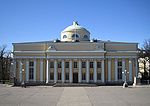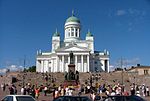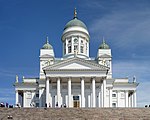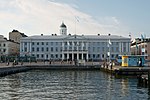Aleksanterinkatu

Aleksanterinkatu (Swedish: Alexandersgatan; "Alexander Street") is a street in Kluuvi, the commercial centre of Helsinki, Finland. In the city plan by Carl Ludvig Engel, it was the Decumanus Maximus, the main east–west street in the city, crossing the Cardo, Unioninkatu (Union Street) at the corner of the Senate Square. The street begins near the Presidential Palace and continues to meet with Mannerheimintie, the longest street in Helsinki. It runs past several famous buildings, such as Ritarihuone (the seat of Finnish nobility), the Helsinki Cathedral, the former Finnish main office of the Nordea bank, the main building of the University of Helsinki, and the Stockmann department store. The street, colloquially known in Helsinki as "Aleksi" (Swedish: "Alexen"), was named for Emperor Alexander I of Russia in 1833. It was originally named Suurkatu (Swedish: Storgatan), meaning "Grand Street", but was renamed after the Emperor's death in his honour. The streets crossing Aleksanterinkatu are named after the Emperor's mother, his brothers, and his sisters. Aleksanterinkatu has been the official Christmas street of Finland since 1949. At Christmas time, Aleksanterinkatu is traditionally decorated with elaborate Christmas lights between Unioninkatu and the Three Smiths Statue from late November to Epiphany. The tram lines 2, 4, 5 and 7 run along Aleksanterinkatu. Of these, only 4 and 5 run along the street's entire length.
Excerpt from the Wikipedia article Aleksanterinkatu (License: CC BY-SA 3.0, Authors, Images).Aleksanterinkatu
Unioninkatu, Helsinki Kaisaniemi (Southern major district)
Geographical coordinates (GPS) Address Nearby Places Show on map
Geographical coordinates (GPS)
| Latitude | Longitude |
|---|---|
| N 60.169 ° | E 24.951 ° |
Address
Unioninkatu
Unioninkatu
00130 Helsinki, Kaisaniemi (Southern major district)
Finland
Open on Google Maps









